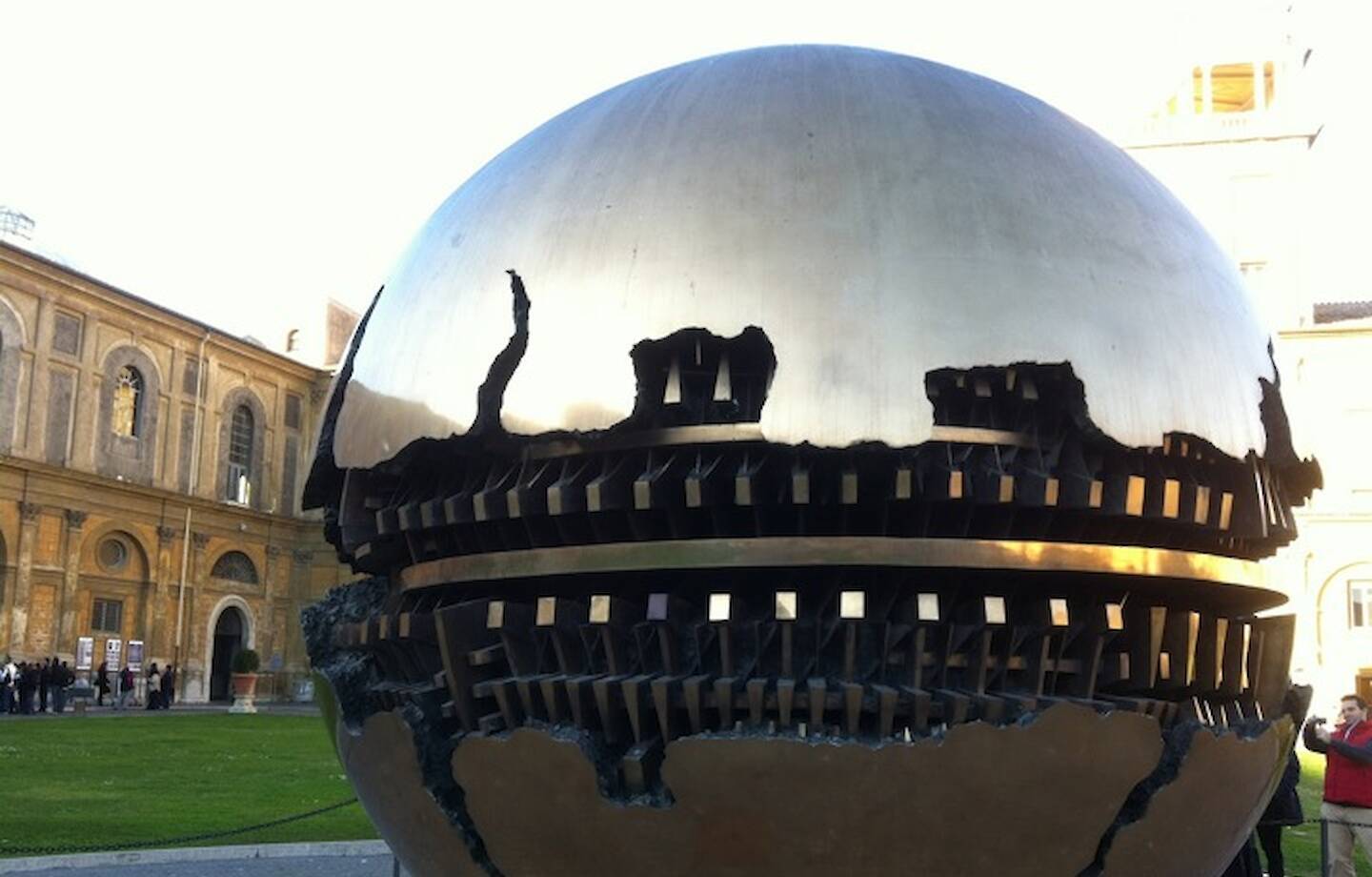Upcoming Kentner Anderson Premieres
Clarinet Trio "1918"
Contrasts Ensemble
--Evelyne Luest, piano; Anoush Pogossian, clarinet; Nurit Pacht, violin--
May 18, 8pm Greenwich House
--46 Barrow Street, Greenwich Village
"1918" is a strange piece to happen to me, but, obvious after the fact.
The Contrasts Ensemble is pairing "1918" with Brahms op. 114. That was always the intended pairing. The piece lifts off from a freshly deployed contrapuntal device found in the third movement of Brahms'
Clarinet Trio, op. 114. The opening and its recap lift off from the friendlist mininalist texture.
That op. 114 procedure, adapted, is then treated to the Brahms op. 15 process (another contrapuntal/harmonic device) in the recap.
The recap has a Bruckner sunrise.
The move in the recap goes into some Robert Morris territory that is reserved for mention later for the wonks.
Why not just imitate Schoenberg?
Because that's what so many did. Moreover, Schoenberg was forced by circumstances into being a bridge burner. I'm in a different place. The minimalists wiped the slate clean for me, allowing me to imagine my own fresh ways of setting Brahmsian precedures into motion.
By "Brahmsian procedures" I mean the most memorable and astounding developments in music before it all collapsed.
I love Schoneberg and his on-shoring here in the US by the likes of my late friend Milton Babbitt and his Schoenbergians. That on-shoring involved scrubbing away the redolences of bridge-burning that comes with Schoenberg, and adapting Schoenberg's ways into something more generally portentous of a rich musical future.
I admire the minimalists for building an audience for new music in the US. What a wonderful and surprising development. The Metropolitan Opera finds it easier to sell tickets for new operas than old ones, a healthy state of affairs.
I honor both Schoenberg and the minimalists here. I defy both.
I surprised myself by becoming close to David Del Tredici in his last few years. Herrick's Oratorio and his 2nd String Quartet are asonishing masterpieces. He was a Princetonian to the end, but he knew how to keep his modernist tricks in reseeve for the right moments. Call those A-roll moments. Let there be B-roll! David & I are both picaros, tricksters. I also think of my old friend Meyer Kupferman, another trickster. He wanted everything and often got it, but not always without avoiding a sense of collage or pastiche. His heart was in the right place, yearning for integration.
*Integrators* can annoy those who heed the gatekeepers.
Wonks Only:
The opening device extracts or condenses 0156, which then governs the surface up to the recap. 0156 is shiftless. It is a powerful signature of one diatonic septachord. Where ever you move it, you're at home there, rooted in that one "key", that one diatonic septachord in which it's embedded.
When 0156 is extended through the [1, 4....] cycle to 015678 (01459t), that crystallizes the Ionian/Lydian or Ionian/Mixolydian. A little "In C" gag.
It invites this figure:
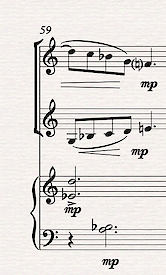
//////////
0156 can be presented as pairs of semitones or pairs of 5ths. That partition is more noticable than any transpositions because transpositions of 0156 are shiftless, always perfectly happy to sit where they lie. The nearby transpositions are *presentiated*, rendered an atemporal fact, diachronic, as they are congealed as 01459t
//////////////
The brass sphere -- non-triadic music can have explosions such as Beethoven's explosive augmented 6 chords. This is a move that happens in "1918" also also in "Mille Regrez" --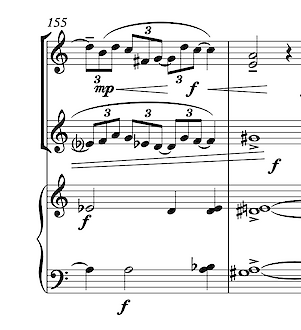
I think of complementary diatonic hexachords (or tritone transpositions of the diatonic septachord) as being akin to atom splitting. And this is where I like to invoke the image of the brass sphere.
////////////////
The middle section is Kupferman/Chagall leading first to a Dresden Amen. After the Dresden Amen a passage with only 8 notes ensues -- the 1,4 cycle taken to 8 members. It was curious to discover that the remaining 4 notes is 0127 -- a tetrachord that got in my bones through Milton Babbitt's Swan Song.
That 0127 appears the op. 15 recap.
Opening:
Like op. 15, D is a pedal tone.

Recap:
0156 transposed up a tritone and with the D pedal tone imbricated.
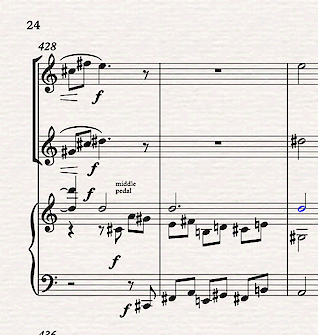
It's now a horrific Bob Morris cluster -- 01267.
These subsets, extrinsic to the preceding music, are manifested in the recap --
0127 [D, D#, E, A]
0167 [D, Eb, Ab, A]
This passage in the "key" of 0156 (partitioned as 5ths a semitone apart) comes back in the recap--
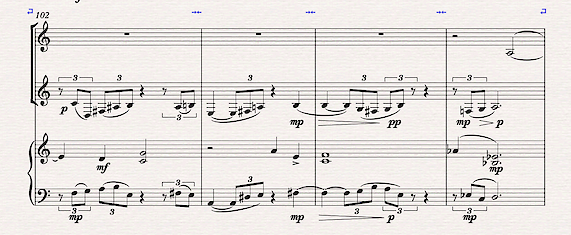
In the recap, the same passge is embedded in a 12-bar passage in the "key" of 0167, partitioned in 5ths a tritone apart --
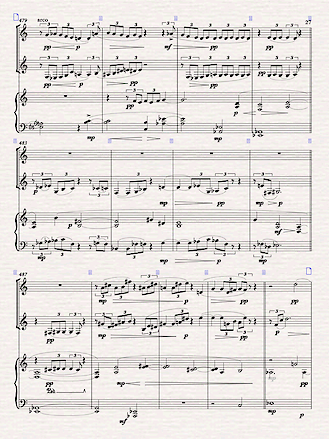
The ending of the piece manifests another partition of 0167 -- two tritones, a fifth apart.
Piano Trio "Mille Regrez"
This all came about through a conviction that my setting of Gillian Welch's "My Morphine" would be easily relatable to the all-trichord hexachord. My setting of "My Morphine" is in the "key" of 0156, which is close, but nevertheless extrinsic to the all-trichord hexachord. My Morphine displaces the ATH.
The music that precedes "My Morphine" develops subsets of the ATH, including pretty ones that were too pretty for Carter.
More on this shortly.
